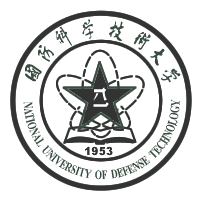National University of Defense Technology
The National University of Defense Technology (NUDT, Chinese: 国防科技大学), or People's Liberation Army National University of Defense Science and Technology (Chinese: 中国人民解放军国防科技大学), is a military academy and Class A Double First Class University[1] located in Changsha, Hunan, China. It is under the direct leadership of China's Central Military Commission, and the dual management of the Ministry of National Defense and the Ministry of Education. It is designated for Project 211 and Project 985, the two national plans facilitating the development of Chinese higher education. NUDT was instrumental in the development of the Tianhe-2 supercomputer.
 | |
Former names | Harbin Military Academy of Engineering Changsha Institute of Technology |
|---|---|
| Motto | 厚德博学、强军兴国 |
Motto in English | Excel in Virtue and Knowledge; Strengthen the Armed Forces and the Nation |
| Type | National Key University Military Academy |
| Established | September 1, 1953 |
| Affiliation | Central Military Commission (China) |
| President | Lt. Gen. Deng Xiaogang (2017-) |
Academic staff | 2,000 faculty members |
| Students | 15,700 |
| Undergraduates | 8,900 |
| Postgraduates | 6,800 |
| Location | , , China |
| Campus | 373 hectares, or 922 acres |
| Website | www |
| National University of Defense Technology | |||||||
|---|---|---|---|---|---|---|---|
| Simplified Chinese | 国防科技大学 | ||||||
| Traditional Chinese | 國防科技大學 | ||||||
| |||||||

History
NUDT was founded on 1 September 1953 as the People's Liberation Army Military Academy of Engineering (Chinese: 中国人民解放军军事工程学院) or Harbin Military Academy of Engineering (Chinese: 哈尔滨军事工程学院) under the direct leadership of the Chinese Central Military Commission. Grand General Chen Geng was appointed the first President. It was located in Harbin, Heilongjiang Province, in Northeastern China, close to the border with the former Soviet Union.
The university was founded as the premier military academy of China. It had five departments and one prep department at the time of its founding, including departments of Air Force Engineering, Artillery Engineering, Naval Engineering, Armoring Force Engineering, and Corps of Engineers. The departments of Chemical Warfare and Nuclear Warfare were established later.
During the Cultural Revolution, the university was transitioned to the Committee of National Defense Science and Technology, and was renamed Harbin Academy of Engineering in 1966. In 1970, the main body of the university including its central administration and 4 departments moved to Changsha in South-Central China due to the possible war with the Soviet Union, and was renamed Changsha Institute of Technology. Other departments were converted to at least five independent national universities, or taken by other national universities or science research institute. The university's name was changed to People's Liberation Army National University of Defense Science and Technology in 1978 after the Cultural Revolution was over.
Campus
NUDT is located in the urban area of Changsha, capital of Hunan Province in South-Central China, covering a total area of 373 hectares, or 922 acres.
Administration
- President: Lt. Gen. Deng Xiaogang, Academician of the Chinese Academy of Sciences
- Political Commissar: Lt. Gen. Liu Nianguang
Academics
The university consists of 11 colleges administering over 40 departments, institutes and laboratories, four national key laboratories and one key laboratory at the Ministry of Education level.
The 11 colleges of the university include:
- College of Liberal Arts and Sciences
- College of Systems Engineering
- College of Computer Science and Technology
- College of Electronic Engineering
- College of Electronic Science and Technology
- College of Meteorology and Oceanography
- College of Advanced Interdisciplinary Studies
- College of Information and Communication
- College of Intelligence Science and Technology
- College of Aerospace Science and Engineering
- College of International Studies
Statistics
Currently, NUDT has over 2,000 faculty members, over 300 of whom are professors. There are 14,000 full-time students including 8,400 undergraduates and 5,600 graduates. NUDT offers 25 subjects for undergraduates, 112 programs for master's degree candidates, and 69 programs for PhD candidates. 11 post-doctoral research stations have been authorized on campus.
NUDT supercomputers
- Yinhe-I (YH-I)
Yinhe-1 was developed in 1983 as the leading supercomputer in China with a performance level of 100 MFLOPS.
- Yinhe-II (YH-II)
Yinhe-II was built in 1992 achieving performance of 1 GFLOPS.
- Yinhe-III
Yinhe-II was upgraded to Yinhe-III in 1996 which achieves 13 GFLOPS.[2][3]
- Tianhe-I
Tianhe-I was first revealed to the public on 29 October 2009, and was immediately ranked as the world's fifth fastest supercomputer in the TOP500 list released at the 2009 Supercomputing Conference (SC09) held in Portland, Oregon, on 16 November 2009.
- Tianhe-IA
In October 2010, Tianhe-IA, an upgraded supercomputer achieving a performance level of 2.57 PFLOPS,[4] was unveiled at HPC 2010 China and ranked as the world’s fastest supercomputer in the TOP500 list.[5] [6]
In November 2011, the Tianhe-1A ranked as the second fastest supercomputer in the world on TOP500 after it was surpassed by K Computer by Fujitsu of Japan.
Tianhe-2 was the fastest supercomputer in the world until 2016, when it was surpassed by Sunway TaihuLight at the Chinese National Supercomputing Center.[7]
- Tianhe-2A
Tianhe-2A is currently ranked as the world's fourth fastest supercomputer on the TOP500 list, having achieved a performance level of 61.44 PFLOPS[8]
References
- "教育部 财政部 国家发展改革委 关于公布世界一流大学和一流学科建设高校及建设 学科名单的通知 (Notice from the Ministry of Education and other national governmental departments announcing the list of double first class universities and disciplines)".
- "China's Indigenous Supercomputer Development". nti.org. January 1996. Archived from the original on 2011-06-04.
- Michael Pecht, China's Electronics Industry: The Definitive Guide for Companies and Policy Makers with Interest in China, 2006, ISBN 978-0-8155-1536-4, chapter 3.7.4 China's Supercomputers, page 66
- "China Wrests Supercomputer Title From U.S." New York Times (Press release). 28 October 2010.
- "China Grabs Supercomputing Leadership Spot in Latest Ranking of World's Top 500 Supercomputers" (Press release). TOP500. 11 November 2010.
- "Chinese supercomputer ranked world's fastest by TOP500" (Press release). Peopledaily.com.cn. 17 November 2010.
- "China builds world's most powerful computer". BBC News. 2016-06-20. Retrieved 2016-06-20.
- "TOP500 Supercomputer Sites". 2018-09-28. Retrieved 2018-09-28.
External links
| Wikimedia Commons has media related to National University of Defense Technology. |
- National University of Defense Technology official website (in Chinese)
- National University of Defense Technology official website (in English)
- China's Supercomputer Fastest in the World (in English)
- Fear Not China’s Supercomputer (in English)
- 2016中国大学排行榜, 国防科大跻身7星级大学 (in Chinese)
